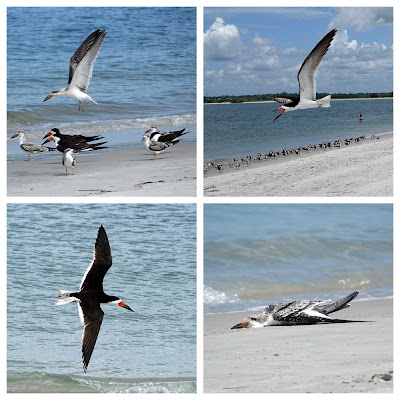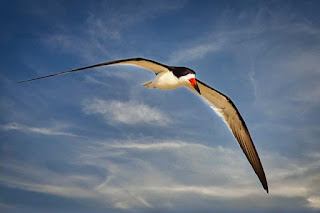Thursday, October 14, 2021
Friday, August 27, 2021
A Peaceful Ending for a Successful Nesting Season
We are approaching the end of the nesting season and the bird posting has been pretty quiet.
Last Wednesday, 8/18, one of our Wrightsville Beach Bird Stewards, Candance Gauthier wrote this summary after her time at the south end.
“I was at the beach last night from 6 PM until 8:15 PM. I went around the long way and was getting worried since I didn't see any birds for a long time. Around the point, I saw about 30 Black Skimmers coming off the water at Banks Channel. I saw one fledgling with them.
I found TEX alone on that side, too…just walking around on the sand. Doubling back, I finally located one last Black Skimmer juvenile past the point, on the Inlet side. He was sitting or walking on the beach by the vegetation, being protected by 3- 5 adults who were diving at me when I got too close. I stayed with him and saw him try to fly but he wasn't quite ready.
Later, I walked back around the point to check on Tex (banded ETX). I found him with his parent and they were walking around and finally they both took off, flying over the point toward the Inlet.
 |
| photo by Camille Daniels |
 |
| photo by Camille Daniels |
 |
| photo by Camille Daniels |
 |
| photo by Camille Daniels |
 |
| photo by Camille Daniels |
 |
| photo by Camille Daniels |
 |
| photo by Camille Daniels |
BLACK SKIMMERS
As Candace mentioned above, we had one remaining Black Skimmer chick that was seen regularly at the point of the nesting colony protected by 3-4 adult Black Skimmers. Then on Tuesday, 8/25, several Bird Stewards came across the Black Skimmer juvenile near the point on the inlet side. The chick flew several times in response to folks walking down the beach toward him. He flew probably the equivalent of about four posts from the post line on the inlet side to the beach near the water. Then from one side of the point to the other side by the ocean. He took off from there and did a loop through the posting and came back to the beach. Again he flew down the beach to the point. There he spent much of the time pancaked on the sand. The parent(s) chased off gulls several times. So it appears our last chick is ready to "leave the nest".
Our remaining Black Skimmer chick was banded by Lindsay on Tuesday, 8/17.
OYSTERCATCHER
Our young Oystercatcher (banded ETX) aka “Tex” is flying across the inlet to the marsh and learning from its parent how to find and open bivalves, such as razor clams, oysters and mussels.
LEAST TERNS AND COMMON TERNS
Both Least Tern and Common Tern fledglings can often be seen on the beach as they perfect both their flying and fishing skills.
Tuesday, August 10, 2021
End of Nesting Season Approaches
 |
| Photo by Mary-Ann Walton |
We are approaching the end of the nesting season and the bird posting is quiet. Important bird activity is still happening in the area of the south end!
WHERE ARE THE BIRDS???...
LEAST TERNS
 |
| Photo by Tom Hanna |
The Least Terns have left the posting, but training of fledglings in fishing and strong flying skills is happening as they begin migration. Feeding of fledglings by the parent birds will continue through migration as they improve their own fishing skills.
We have just a couple of fledglings remaining on the beach from the last nests that hatched by access 43 (Gazebo). You may see those fledglings on the oceanfront area of the posting.
BLACK SKIMMERS
 |
| Black Skimmer photos by Tom Hanna |
It appears that the “second phase” nests of Black Skimmers that were in the oceanfront area of the posting have failed. No Black Skimmers have been seen in this area in several days. Several days of heat index over 100 degrees and the torrential rains (my rain gauge reflected 11 ½ inches of rain in 3 days last week impacted the nesting. As you know, temperature regulation of the eggs is critical during incubation for successful hatching, and the weather was too extreme.
 |
| Photo by Camille Daniels |
The first group of Black Skimmers that nested are continuing the training of the Black Skimmer fledglings as they improve their skimming and flying skills in the inlet (Masonboro Inlet). Many Black Skimmers can be seen across the inlet and on Masonboro Island. Skimming also takes place in the local tidal creeks.
OYSTERCATCHERS
Our young Oystercatcher (banded ETX) aka “Tex” is flying across the inlet now and training with its parent in the marsh to learn how to find food during low tide. Training takes place generally 2 hours before and after low tide.
Unsure of the timing of the High and Low Tides, look at the Tide chart for Masonboro Inlet in the Wrightsville Beach magazine or add an app to your phone…. I use the “My Tide Times” app.
You will see the Oystercatchers coming to the nesting area now to rest during High Tide and Mid Tide times.
Wednesday, August 4, 2021
Lots of Empty Nests = Another Successful Season
The bird posting may be quiet, but important bird activity is happening in the area of the south end!
LEAST TERNS
Most of the Least Terns have left the posting, but training of fledglings in fishing and strong flying skills is happening as they prepare for migration. Feeding of fledglings by the parent birds will continue through migration as they improve their own fishing skills.
We have just a few fledglings remaining on the beach from the last nests that hatched by access 43 (Gazebo). You will see those fledgling on the oceanfront beach in front of the new skimmer nesting area.
BLACK SKIMMERS
We have another group of about 31 Black Skimmers incubating eggs and caring for small chicks in the oceanfront area of the posting… so when you include the mates you will see about 68 Black Skimmers!
The first group of Black Skimmers that nested are continuing the training of the Black Skimmer fledglings as they improve their skimming and flying skills in the inlet (Masonboro Inlet). Many Black Skimmers can be seen across the inlet and on Masonboro Island. Skimming also takes place in the local tidal creeks.
OYSTERCATCHERS
Our sweet young Oystercatcher (banded ETX) aka “Tex” is flying across the inlet now and training with its parent in the marsh to learn how to find food during low tide. Training takes place generally 2 hours before and after low tide.
Wednesday, July 28, 2021
New Black Skimmer Chicks Hatch and the Fledglings Take to the Air
 |
| photo by Dorothy Sutherland |
LEAST TERNS – LETE
We have been counting Least Tern fledglings! High count so far last week was 36. Who do we count? A LETE fledgling is any chick with flight feathers, i.e. not fuzzy!
 |
| Photo by Camille Daniels |
BLACK SKIMMERS – BLSK
A new colony of skimmers are nesting oceanside. On the morning of July 22 our count revealed 36 new nests oceanfront and 11 nests inlet side…47 total! New chicks were seen on 7/22 in the oceanfront colony. And this morning, 7/28, even more chicks are making an appearance.
 |
| Photos by Dorothy Sutherland |
 |
| Photos by Dorothy Sutherland |
Look for bands on adult and juvenile Black Skimmers.
AMERICAN OYSTERCATCHER – AMOY
Our chick “Tex” (banded ETX) is doing very well and we expect him/her to fly soon.
 |
| Photo by Camille Daniels |
Saturday, July 17, 2021
Flying Fledglings Continue to Impress Us
 |
| photo by Tom Hanna |
LEAST TERNS (LETE) – We have Least Terns chicks everywhere and several have decided to leave the posting to go to the water…including very little ones. If you see a chick making its way to the water, just walk with it and allow it to go to the water. One of our beach stewards was on the beach yesterday afternoon and experienced this first hand. The fuzzy chick walked to the water, got a drink and splashed and then walked back to the posting.
Parent birds are spending the day feeding and protecting their MANY chicks from the heat and potential predators.
 |
| photo by Tom Hanna |
 |
| photo by Tom Hanna |
COMMON TERNS (COTE) – Common Tern chicks and fledglings can be seen throughout the posting and on the beach. The parent birds are encouraging the COTE fledglings to fly over the inlet.
 |
| photo by Tom Hanna |
 |
| photo by Tom Hanna |
 |
| photo by Tom Hanna |
We also discovered two new Common Tern nests so little chicks are visible from the Masonboro Inlet side of the posting.
BLACK SKIMMERS (BLSK) – A group of biologists met again this week at sunrise to band more Black Skimmer chicks. Capturing and banding non-flying Black Skimmer chicks takes place in phases as the chicks grow.
We have a second wave of nesting as about 30 pairs of Black Skimmers continue in incubate nests close to the posting.
 |
| photo by Tom Hanna |
Black Skimmer chicks can be seen throughout the posting and are getting good size. We are seeing juvenile BLSK flying over the inlet and practicing skimming skills this week. A total of 26 Black Skimmer fledglings were recently counted at the water’s edge and “skimming school” has begun!
 |
| photo by Tom Hanna |
AMERICAN OYSTERCATCHERS (AMOY) – We are sadden to report that our injured Oystercatcher chick has not been seen for several days…which has been expected.
The good news is that the second chick banded ETX aka “Tex” is doing great! The fact that we have a chick from this nesting developing so well after both of its parents sustained injuries and later one parent died is remarkable. The good news is that Tex is reaching a really good size and will develop even faster now that the parent bird is feeding it exclusively. Tex was seen this week taking a little flight on the beach. You will see Tex, the Oystercatcher chick, unsupervised on the beach during low tide and it is “street/beach smart” running into the posting as vehicles or people approach.































